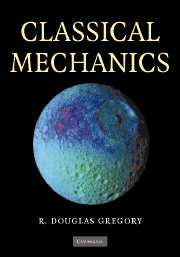Book contents
- Frontmatter
- Contents
- Preface
- 1 Newtonian mechanics of a single particle
- 2 Multi-particle systems
- 3 Analytical mechanics
- 4 Further topics
- 15 The general theory of small oscillations
- 16 Vector angular velocity and rigid body kinematics
- 17 Rotating reference frames
- 18 Tensor algebra and the inertia tensor
- 19 Problems in rigid body dynamics
- Appendix Centres of mass and moments of inertia
- Answers to the problems
- Bibliography
- Index
17 - Rotating reference frames
Published online by Cambridge University Press: 05 September 2012
- Frontmatter
- Contents
- Preface
- 1 Newtonian mechanics of a single particle
- 2 Multi-particle systems
- 3 Analytical mechanics
- 4 Further topics
- 15 The general theory of small oscillations
- 16 Vector angular velocity and rigid body kinematics
- 17 Rotating reference frames
- 18 Tensor algebra and the inertia tensor
- 19 Problems in rigid body dynamics
- Appendix Centres of mass and moments of inertia
- Answers to the problems
- Bibliography
- Index
Summary
KEY FEATURES
The key features of this chapter are the transformation of velocity and acceleration between frames in general relative motion, and the dynamical effects of the Earth's rotation.
So far we have viewed the motion of mechanical systems from an inertial reference frame. The reason for this is simple; the Second Law, in its standard form, applies only in inertial frames. However, circumstances arise in which it is convenient to view the motion from a non-inertial frame. The most important instance of this occurs when the motion takes place near the surface of the Earth. Previously we have argued that the dynamical effects of the Earth's rotation are small enough to be neglected. While this is usually true, there are circumstances in which it has a significant effect. In long range artillery, the Earth's rotation gives rise to an important correction, and, in the hydrodynamics of the atmosphere and oceans, the Earth's rotation can have a dominant effect. If we wish to calculate such effects (as seen by an observer on the Earth), we must take our reference frame fixed to the Earth, thus making it a non-inertial frame. The downside of this choice is that the Second Law does not hold and must be replaced by a considerably more complicated equation.
In addition to applications involving the Earth's rotation, there are instances where the motion of a system looks much simpler when viewed from a suitably chosen rotating frame.
- Type
- Chapter
- Information
- Classical Mechanics , pp. 469 - 491Publisher: Cambridge University PressPrint publication year: 2006



